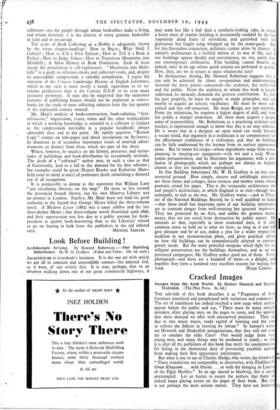Look Before Building !
Architecture Arising. By Howard Robertson.—Our Building Inheritance. By W. H. Godfrey. (Faber and Faber. 10s. 6d. each.) ARCHITECTURE is everybody's business. It is the one art with which we are all in constant and unavoidable. contact—the national loaf, as it were, of our artistic diet. It is true, perhaps, that to an observer walking down one of our great commercial highways, it may seem less like a loaf than a synthetic-looking cake, in which a heavy mass of routine building is occasionally studded by the few hopelessly dried fruits 'of revivalism, and garnished with the glamorous but fragile icing whipped up by the avant-garde. But for this flavourless concoction, architects cannot alone be blamed. A nation's architecture is a faithful mirror of its way of life, and if our buildings appear shoddy and meretricious, so, too, surely does our contemporary civilisation. Fine building. cannot flourish or, indeed, exist in an age where quick returns are preferred to qualm. How, then, are we to return to more wholesome fare?
In Architecture Arising, Mr. Howard Robertson -suggests that it can only be achieved by closer co-operation and understanding between the three parties concerned—the architect, the technician and the public. From the architect, to whom this book is largely addressed, he naturally demands the greatest contribution. To play his part properly, he must be taught to study principles, and not merely to acquire an eclectic vocabulary. He must be more self- critical and less self-conscious. He must Ilesign, not just assemble. From the technician, he requires a higher degree of skill, and from the public a sharper awareness. All three must acquire a deeper sense of responsibility. Mr. Robertson, as a practising architect and teacher, is experienced enough to know that this is no easy solution. He is aware that in a designer an open mind can easily become a vacant mind, that ingenuity in a technician is no compensation for the affectionate confidence of a craftsman, and that no building can be fully understood by the layman from its surface appearance alone. But he mixes his recipe—where ingredients range from town- planning to sleeping-car equipment—with wit and a truly Wool- tonian persuasiveness, and he illustrates his arguments with a pro- fusion of photographs which are perhaps not always so happily chosen as they are handsomely reproduced.
In Our Building Inheritance 'Mr. W. H. Godfrey is on less con- troversial ground. How simple, sincere and unfailingly attractive are these farms and cottages, these terraces and market towns whose portraits crowd his pages. This is the vernacular architecture, the real people's architecture, in which England is so rich—though not, unhappily, so rich as she was. Mr. Godfrey warns —and as Direc- tor of the National Buildings Record, he is well qualified to judge —that these small but important units of our building inheritance are in constant danger from well-meaning but ignorant improvers. They are protected by no Acts, and unlike the greatest monu- ments, they are not saved from destruction by public outcry. He reminds us that, especially in these straitened days, it is only common sense to hold on to what we have, so long • as it can still give pleasure and be of use, makes a plea for a wider respect for tradition in our reconstruction plans, and gives practical advice on how old buildings can be sympathetically adapted to contem- porary needs. But the most powerful weapons which fight for in- telligent preservation are the buildings themselves, and as an ex- perienced campaigner, Mr. Godfrey makes good use of them. Every photograph—and there are a hundred of them—is a delight, and together they form a hundred very excellent reasons for buying this


























 Previous page
Previous page